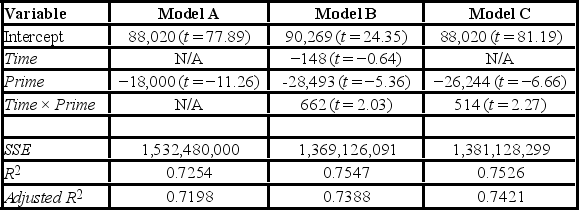Multiple Choice
A researcher wants to examine how the remaining balance on $100,000 loans taken 10 to 20 years ago depends on whether the loan was a prime or subprime loan. He collected a sample of 25 prime loans and 25 subprime loans and recorded the data in the following variables: Balance = the remaining amount of loan to be paid off (in $) ,
Time = the time elapsed from taking the loan,
Prime = a dummy variable assuming 1 for prime loans, and 0 for subprime loans.
The regression results obtained for the models:
Model A: Balance = β0 + β1Prime + ε
Model B: Balance = β0 + β1Time + β2Prime + β3Time × Prime + ε
Model C: Balance = β0 + β1Prime + β2Time × Prime + ε,
Are summarized in the following table.  Note: The values of relevant test statistics are shown in parentheses below the estimated coefficients.
Note: The values of relevant test statistics are shown in parentheses below the estimated coefficients.
Which of the following three models would you choose to make the predictions of the remaining loan balance?
A) Model A
B) Model B
C) Model C
D) Any model
Correct Answer:

Verified
Correct Answer:
Verified
Q1: To examine the differences between salaries of
Q2: Using a _ we can determine if
Q3: According to the Center for Disease Control
Q4: To encourage performance, loyalty, and continuing education,
Q6: The method of maximum likelihood estimation (MLE)
Q7: A bank manager is interested in assigning
Q8: To examine the differences between salaries of
Q9: Consider the regression equation <img src="https://d2lvgg3v3hfg70.cloudfront.net/TB6618/.jpg" alt="Consider
Q10: A binary choice model is also referred
Q11: A dummy variable is also called an